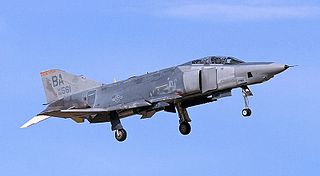
15th Attack Squadron is a United States Air Force unit assigned to the 432d Wing, 732nd Operations Group at Creech Air Force Base near Indian Springs, Nevada. It flies the General Atomics MQ-9 Reaper remotely piloted aircraft.

The 75th Air Base Wing is a wing of the United States Air Force based out of Hill Air Force Base, Ogden Utah. It provides base operating support for the Ogden Air Logistics Complex, the 388th, 419th Fighter Wing, 84th Combat Sustainment Wing, 309th Maintenance Wing, 526th ICBM Systems Wing, 508th Aircraft Sustainment Wing and 25 associate units.

The 91st Cyberspace Operations Squadron is an active United States Air Force unit, currently assigned to the 67th Cyberspace Wing at Kelly Annex, part of Lackland Air Force Base, Texas.

The XXIX Tactical Air Command (Provisional) was a provisional United States Army Air Forces unit, primarily formed from units of IX Fighter Command. Its last assignment was with Ninth Air Force at Weimar, Germany, where it was inactivated on 25 October 1945. The command was formed as a counterpart to IX Tactical Air Command and XIX Tactical Air Command to support the United States Ninth Army throughout its easterly advance from its formation on 15 September 1944, until VE-Day. Following the end of the war, the unit was converted from a provisional unit to a regular unit.

The 16th Electronic Warfare Squadron is an active United States Air Force unit. It is assigned to the 350th Spectrum Warfare Group at Eglin Air Force Base, Florida. The squadron began as the 16th 16th Aero Squadron and redesignated several times over its history with the 16th Aero Squadron, 16th Reconnaissance Squadron, and the 16 Photographic Reconnaissance Squadron being the major redesignations.

The 69th Reconnaissance Group is an inactive United States Air Force that was part of Air Combat Command, the group was stationed at Grand Forks Air Force Base, North Dakota where it was a tenant of the 319th Air Base Wing.

The 4th Reconnaissance Squadron is an active United States Air Force unit, assigned to the 319th Operations Group and stationed at Andersen Air Force Base, Guam, from which it operates RQ-4 Global Hawk unmanned vehicles. It was activated there in July 2020.

The IX Fighter Command was a United States Army Air Forces formation. Its last assignment was with the Ninth Air Force, based at Erlangen, Germany, where it was inactivated on 16 November 1945.

The III Reconnaissance Command is a disbanded United States Army Air Forces unit. Its last assignment was with Third Air Force stationed at Rapid City Army Air Base, South Dakota, where it was inactivated on 8 April 1946. After transferring to the United States Air Force in September 1947, it was disbanded in October 1948.

The III Tactical Air Command was a United States Army Air Forces formation. Its last assignment was with Third Air Force stationed at Barksdale Field, Louisiana. It was disbanded on 24 October 1945. The command was established in 1941 as the 3rd Air Support Command. It was responsible for training tactical units and aircrews for the Army Air Forces, except for the period from August 1943 through March 1944, when it specialized in training reconnaissance units.
The 74th Reconnaissance Group is an inactive United States Air Force unit. It was last assigned to the 91st Air Division at Stewart AFB, New York.
The II Air Support Command is an inactive United States Air Force unit. It was last assigned to Third Air Force at Biggs Field, Texas, as the II Tactical Air Division, where it was inactivated on 22 December 1945.

The I Tactical Air Division is an inactive United States Air Force unit. It was last assigned to Second Air Force, based at Biggs Field, Texas. It was inactivated on 22 December 1945.

The Second Bombardment Wing, abbreviated as 2nd Bombardment Wing of the United States Army Air Forces is a disbanded unit whose last assignment was with the Continental Air Forces, based at McChord Field, Washington. It was last active in November 1945.

The XII Tactical Air Command was a formation of the United States Army Air Forces. Its last assignment was with the United States Air Forces in Europe at Bad Kissingen, Germany, where it was inactivated on 10 November 1947.

The United States Air Force's 543d Intelligence, Surveillance and Reconnaissance Group is an intelligence unit located at Joint Base San Antonio, Texas. It has been located there since 1997, when it was activated as the 543d Intelligence Group. It focuses on cryptologic operations and signals intelligence.

The 318th Cyberspace Operations Group is a United States Air Force information operations unit located at Joint Base San Antonio, Texas. The group was first activated during World War II as the 8th Photographic Reconnaissance Group. After training in the United States, the unit moved to the China-Burma-India Theater and engaged in hostilities until the end of the war. It returned to the United States in November 1945, and was inactivated at the port of embarkation.

The 29th Attack Squadron is a remotely piloted vehicle training unit of the United States Air Force. Assigned to the 49th Operations Group, 49th Wing at Holloman Air Force Base, New Mexico. Flying the General Atomics MQ-9 Reaper. It was activated on 23 October 2009.

The 21st Expeditionary Reconnaissance Squadron is a provisional United States Air Force unit, assigned to United States Air Forces Europe to activate or inactivate as needed. Its last known location was at Souda Bay, Greece.

The 67th Cyberspace Wing is a United States Air Force wing stationed at Lackland Air Force Base, Texas. It was activated in October 1993 as a military intelligence unit and is assigned to the Sixteenth Air Force.





























